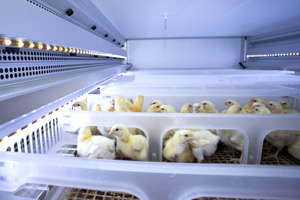A good start reduces the need for antibiotics

Even the most modern broiler houses don’t offer the best environmental conditions for day old chicks. That’s because they are designed for managing the climate for six week old broilers. Keeping day old chicks a few days extra in optimal conditions before transfering them to the house, gives them a good start and reduces the need for antibiotics.
By Conny Maatjens
The first few days after hatch are crucial in the development of a chick. During this early brooding period, chicks need special care to optimise their further development. Although the chick is anatomically complete at hatch, the thermoregulatory, digestive, and immune system are not completely developed yet. Maturation and development of these three main physiological systems are necessary to ensure optimal function of the natural immune system and optimal health during later life. Providing optimal and uniform brooding conditions is extremely important to obtain and maintain the right body temperatures. An optimal body temperature between 40.0 and 40.6˚C will ensure the chick is comfortable and will start to eat and drink.
After hatch, feed and water consumption in combination with the utilisation of nutrients from the yolk are essential to stimulate growth and development of the digestive tract. The digestive tract plays a crucial role in the feed efficiency of chicks. Furthermore, the intestine absorbs nutrients and prevents bacteria and toxins from entering the body. The intestine is the largest lymphoid organ in the body. This implies that the digestive system is of major importance for immune system functioning to keep the health status of the chick stable.
Antibiotic usage
Broiler houses are designed to optimise environmental conditions for six week old broilers. Creating optimal brooding conditions for day old chicks in broiler houses is, therefore, difficult. For young broilers, floor and air temperature need to be uniform and optimally controlled to obtain and maintain optimal body temperatures. In the field, the floor temperature is often too cold when chicks arrive at the broiler house, which results in suboptimal body temperatures. When body temperatures are too low, maturation of the three main physiological systems is retarded, which makes the chick susceptible for infections.
To prevent high mortality and performance losses, antibiotics are used preventively. Currently, antibiotics in the poultry industry are mainly applied to prevent and cure yolk sac infections and intestinal disorders. Field data show that the largest part of antibiotic usage is applied during the first week of life, which indicates that optimal brooding conditions are crucial for an optimal start of a chick’s life without health issues.
Antibiotic resistance
Antibiotics are organic substances
that fight pathogens, mainly bacteria, in the body. Although antibiotics are necessary to prevent and cure diseases, wrong use of antibiotics may lead to resistance, which means that bacteria become less sensitive or even immune to the antibiotics used. Resistance occurs when antibiotics are not dosed properly. Not applying right doses includes administrating antibiotics in a too low dose, or in a too high dose (mainly used preventively). Resistance can also occur when antibiotics are used to try to treat diseases which are caused by viruses, because then antibiotics are ineffective.
Currently, resistance against some antibiotics already exists. Therefore, the main goal in the animal industry for the Netherlands is to reduce the use of antibiotics in 2013 with 50% compared to 2009. Part of the plan to obtain the 50% reduction is to improve environmental conditions for animals. Type of housing system, feed and drinking water availability and quality, and the absence of environmental stressors are crucial in improving these environmental conditions. To optimise early brooding conditions for chicks, HatchTech developed HatchBrood.
Importance of the brooding period
The HatchBrood system is a climate controlled housing system in which chicks stay for four days during the early brooding period before they are transported to the broiler house. In the HatchBrood system environmental factors such as temperature, relative humidity, CO2 level, and air velocity are controlled to maintain uniform brooding conditions. Optimal and uniform brooding conditions ensure correct body temperatures. Optimal body temperatures combined with unlimited access to feed and water implies good development of the digestive tract and optimal yolk utilisation for maternal immunity. In addition, there is no stress to impair immune system development. An optimal start in development during the early brooding period improves the health status of the chick, which reduces the use of
antibiotics and is necessary to ensure good performance during later life.
Field data of 2.4 million HatchBrood chicks (chicks that spent their first four days of life in the HatchBrood system, before being transported to the farm) compared to 2.0 million conventional chicks (chicks that were transported to the farm at day of hatch) reveals an improved health
status of HatchBrood chicks. Antibiotic usage decreased by 50%
for HatchBrood chicks as compared to conventional chicks. In addition, the cumulative mortality at day 38 reduced with more than 20% for HatchBrood chicks as compared to conventional chicks (source: K. Nuijten, broiler grower).These data indicate that the importance of the early brooding period on animal welfare should not be underestimated. HatchBrood optimises brooding conditions and is, therefore, a way to an antibiotic free poultry industry.












